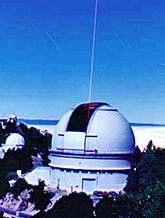Shane Large or Synoptic Approved Programs
Lick Links

Changing Scheduled time on Shane
Shane Time for LSAPs
Call for Small Telescope Proposals
Nickel Remote Observing Policy
Nickel Remote Observing Procedure
Undergraduate Observing Policy
Shane LSAPs
PURPOSE
The LSAP program allows large programs extending for more than one semester, or for a large block of contiguous time in one semester, to be considered and carried out if TAC approved. For programs that extend more than one semester, approval will be granted for a multi-semester time period with continued support of the project for its lifetime contingent on TAC approval of progress evaluated each semester. An LSAP must have well-defined goals that require a large number of nights, either in one semester or over many semesters, to bring it to completion. The program is not to be open-ended, but must have a well-justified total number of nights required for completion. If the nights are to be contiguous, the justification must be particularly strong. LSAPs normally are defined as those requiring 20 or more nights per semester. Although no strict limits are in place, it is anticipated that no more than 1/3 of the total Shane nights will be devoted to LSAPs. Although there is not a requirement for multi-campus participation or multiple co-Is, it is expected that LSAP proposals that involve a collaboration of several UC astronomers will have a better chance of success.
PROCESS
For a program to be accepted for LSAP status, it must be of high scientific merit and very well justified. Therefore, the proposal page limits are larger and there are additional issues to be addressed. The LSAP scientific discussion with figures and references can be up to 6 pages, with a 12 page maximum for the entire proposal. Along with the normally-required sections, an LSAP proposal must include the following:
- a detailed discussion of the scientific goals for the program, including justification for the program having LSAP status. This will generally mean justifying that the entire program is required to realize the scientific goals.
- a clear and well-justified statement of the total number of nights requested.
- an extended discussion of the team involved, making clear individual responsibilities and resources available for carrying out the observations, analysis and dissemination of the results.
Continued allocations of time for approved LSAP programs will depend on evidence of continued good progress. After approval, future requests should include a report of progress to date and distribution of nights and instruments requested for the coming semester. Any papers in press or published should be cited.
It is expected that all of an LSAP PI's Shane time will be devoted to the LSAP, although proposals from the PI’s graduate student(s) will be considered if for an unrelated project. An LSAP PI can submit another proposal, with the understanding that it would be considered only if the LASP is not given time.